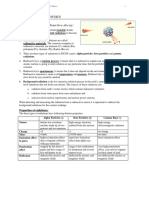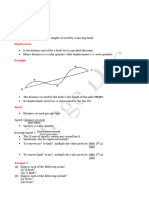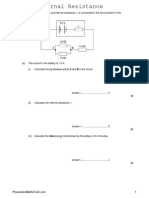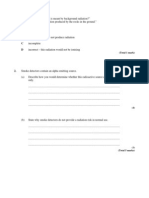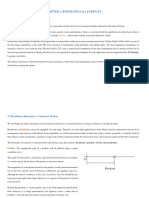Describing Waves With Graphs
Describing Waves With Graphs
Uploaded by
eynestyneCopyright:
Available Formats
Describing Waves With Graphs
Describing Waves With Graphs
Uploaded by
eynestyneCopyright
Available Formats
Share this document
Did you find this document useful?
Is this content inappropriate?
Copyright:
Available Formats
Describing Waves With Graphs
Describing Waves With Graphs
Uploaded by
eynestyneCopyright:
Available Formats
Describing Waves with Graphs
To study the motion of the vibrating particles on a wave, we draw graphs. Two types of graphs are commonly used: the displacement-position graphs and the displacement-time graphs. Displacement-position graphs A displacement-position graph is also called a displacement-distance graph. It shows the displacement of the particles at various positions at a certain time. Although it looks like a photograph of a transverse wave, it can be used to describe BOTH a transverse and a longitudinal wave (Figures a and b).
Figure a Displacement-position graph of a transverse wave at t=0.
Figure b Displacement-position graph of a longitudinal wave at t=0.
From a displacement-position graph, we can directly read the following information:
y y y
amplitude of the wave wavelength of the wave locations of crests and troughs (for a transverse wave), or compressions and rarefactions (for a longitudinal wave)
The displacement-position graph is especially useful to study a longitudinal wave. For example, look at the displacement of compression: it is zero unlike the crest. This is easy to notice on the graphs.
Figure c Time series of displacement-position graphs of a wave.
Using a series of displacement-position graphs at various time, we can see the motion of the wave (Figure c). By comparing the changes in these graphs, we can deduce the travelling speed and direction of the wave, as well as the time-varying directions of the motion of the vibrating particles.
Displacement-Time Graphs Unlike a displacement-position graph, a displacement-time graph describes the displacement of ONE particle at various time at a certain position. Figure d shows how the displacements of particles P, Q, and R in Figure c vary with time. Each particle has its own displacement-time graph.
Figure d Displacement-time graphs for particles at different positions.
On the contrary, using a number of displacement-time graphs at various position, we can construct back the displacement-position graph of the wave at a certain time. From a displacement-time graph, we can directly read the following information:
y y y
amplitude of the wave period of the wave (and hence, the frequency) direction of motion of the particle at various time
If we have a snapshot of the wave too, we can deduce from them the motion of the wave: its travelling speed and direction.
Phase of Waves
The phase of a wave is the offset of the wave measured in degrees to a plane or another wave. Figure e. shows two waves and the phase shift (difference)
Figure e
between each. There are three special cases of a wave s phase in comparison to another wave.
Figure f shows these comparisons. When two or more waves are in phase their amplitude adds to create a larger wave. That is, an increase in amplitude. If the waves are partially out of phase , there is some addition and some subtraction. The third case occurs when the waves are completely out of phase , both waves
Figure f
cancel each other. These three effects are called interference. Figure g shows the result for each case. In the first case there is constructive interference. In the second case there is total destructive interference: the waves cancel. The third case there is partial destructive interference.
Figure g
Figure h shows a graph of amplitude and phase angle of two waves. Note that the angle is being measured from the plane to the apex of the crest of wave E1. There phase angle here is 90.The phase of E2 is approximately 180 from the plane. This makes is 90 out of phase with E1.
Figure g
You might also like
- Electricity Workbook PDFDocument8 pagesElectricity Workbook PDFКарина Сагратова100% (1)
- Paper 1 Questions On MomentumDocument12 pagesPaper 1 Questions On MomentumAhmed DataNo ratings yet
- A2 Physics Monthly Test January 2017Document3 pagesA2 Physics Monthly Test January 2017AbhiKhanNo ratings yet
- G9 UK W20 - General Properties of WavesDocument26 pagesG9 UK W20 - General Properties of Waveshk6sd6cf7vNo ratings yet
- WAVESDocument9 pagesWAVESimandimahawatte2008No ratings yet
- Understanding Waves: Physics Module Form 5 Chapter 1 - Waves GCKL 2010Document29 pagesUnderstanding Waves: Physics Module Form 5 Chapter 1 - Waves GCKL 2010Roy LimNo ratings yet
- 4.5 Electromagnetic EffectsDocument24 pages4.5 Electromagnetic EffectsSolutions ManualNo ratings yet
- Forces, Density, and PressureDocument21 pagesForces, Density, and PressureYossef AmrNo ratings yet
- Turning Effect of ForcesDocument21 pagesTurning Effect of ForcesanghwaijenNo ratings yet
- Science (Physics) Notes2 (Super Quick Revision)Document4 pagesScience (Physics) Notes2 (Super Quick Revision)rsiva98No ratings yet
- Physics CH 1 - Making Measurements-NotesDocument14 pagesPhysics CH 1 - Making Measurements-NotesBhagwat Singh RathoreNo ratings yet
- YEAR 11 2022-2023 Chapter 2 Accelerated MotionDocument19 pagesYEAR 11 2022-2023 Chapter 2 Accelerated MotionRiza Firmansyah100% (1)
- Multiple-Choice Question 1985 Take G 10 m/s2.: Velocity/msDocument16 pagesMultiple-Choice Question 1985 Take G 10 m/s2.: Velocity/mssliversniperNo ratings yet
- Understanding Waves: - Physics Module Form 5 Chapter 1: Waves GCKL 2011Document29 pagesUnderstanding Waves: - Physics Module Form 5 Chapter 1: Waves GCKL 2011rush7240No ratings yet
- General Wave Properties PPT Notes Olevel PhysicsDocument33 pagesGeneral Wave Properties PPT Notes Olevel PhysicsMeerab FatimaNo ratings yet
- h2 A Level Physics Definition ListDocument4 pagesh2 A Level Physics Definition ListJanel NgNo ratings yet
- 11 SuperpositionDocument75 pages11 SuperpositionRonnie QuekNo ratings yet
- Light & WaveDocument11 pagesLight & WaveDewan Olin ChotepadaeNo ratings yet
- Cathode Ray OscilloscopeDocument16 pagesCathode Ray OscilloscopeGaurav SharmaNo ratings yet
- Class 7 - Pressure and Archimedes PrincipleDocument18 pagesClass 7 - Pressure and Archimedes PrincipleDaimani ForresterNo ratings yet
- Worksheet (AS) PDFDocument3 pagesWorksheet (AS) PDFMahad AsimNo ratings yet
- Radioactivity or Radioactive Decay:: Topic 5 - Atomic PhysicsDocument5 pagesRadioactivity or Radioactive Decay:: Topic 5 - Atomic PhysicsAbdullah MACNo ratings yet
- Waves - Interference 2 5213464Document19 pagesWaves - Interference 2 5213464David HolmesNo ratings yet
- Internal ResistanceDocument4 pagesInternal Resistancenewabrown1012No ratings yet
- Edexcel Physics IGCSE: Forces and MotionDocument8 pagesEdexcel Physics IGCSE: Forces and MotiondilsharakaviNo ratings yet
- Archimedes PrincipleDocument2 pagesArchimedes Principledemetri lanezNo ratings yet
- UNIT 12-PHY 131-Chapter 17-Electric PotentialDocument32 pagesUNIT 12-PHY 131-Chapter 17-Electric Potentialcharlie100% (1)
- Progressive WavesDocument8 pagesProgressive WavesdilsharakaviNo ratings yet
- DC Circuit TheoryDocument20 pagesDC Circuit TheoryKhushandra SharmaNo ratings yet
- Linear Motion FinalDocument23 pagesLinear Motion Finalblazemwangi59No ratings yet
- Chapter 21: The Electric Field I: Discrete Charge DistributionsDocument114 pagesChapter 21: The Electric Field I: Discrete Charge Distributionsjclv.youknow8373No ratings yet
- 3 WavesDocument23 pages3 WavesApapond Jirasirichote100% (2)
- 3.5 Current Electricity (II)Document19 pages3.5 Current Electricity (II)cecilialaventineNo ratings yet
- 1.5 Forces WS 2Document2 pages1.5 Forces WS 2AHNAF CREATIONNo ratings yet
- Simple BarometerDocument11 pagesSimple BarometerNg YieviaNo ratings yet
- 3B Revision PDFDocument21 pages3B Revision PDFpraphul4uNo ratings yet
- Chapter 16 CommunicationDocument160 pagesChapter 16 CommunicationPathmanathan Nadeson100% (1)
- Circuits 1Document29 pagesCircuits 1Gul Hassan MalikNo ratings yet
- Oscillations QuestionsOscillations QuestionsDocument61 pagesOscillations QuestionsOscillations QuestionsAli SajjadNo ratings yet
- 2.4 Internal Resistance PDFDocument16 pages2.4 Internal Resistance PDFschlemielzNo ratings yet
- PhysicsDocument12 pagesPhysicscbsegirlsaipmtNo ratings yet
- Circular Motion: - Uniform Circular Motion (Constant Centripetal Acceleration) - Motion With A Tangential and RadialDocument14 pagesCircular Motion: - Uniform Circular Motion (Constant Centripetal Acceleration) - Motion With A Tangential and RadialAngelo SaysonNo ratings yet
- Physics Y10 Term 2 Exam Paper1Document14 pagesPhysics Y10 Term 2 Exam Paper1Ezra Loganathan MuniandiNo ratings yet
- Activity - Critical AngleDocument1 pageActivity - Critical AngleUnknownNo ratings yet
- The Doppler Effect - Multiple Choice QuestionsDocument2 pagesThe Doppler Effect - Multiple Choice Questionsjonni sitorusNo ratings yet
- Superposition of WavesDocument23 pagesSuperposition of WavesPhysics IBNo ratings yet
- 2015 PhySc GRD 12 Photoelectric Effect NotesDocument48 pages2015 PhySc GRD 12 Photoelectric Effect Notesdatboydion1No ratings yet
- Physics G10 - 1 WavesDocument4 pagesPhysics G10 - 1 WavesAli SalamehNo ratings yet
- Thermal EnergyDocument12 pagesThermal EnergyBoedisantosoNo ratings yet
- Form 5 Phy MR Theva 25.05.2023Document29 pagesForm 5 Phy MR Theva 25.05.2023LittleDavieGNo ratings yet
- WAVESDocument28 pagesWAVESAbdallah Soud AllyNo ratings yet
- Nota Chapter 1 Physics Form 4Document23 pagesNota Chapter 1 Physics Form 4Haninii Suhaila HK100% (1)
- Unit 5 Physics Nuclear Decay QuestionsDocument58 pagesUnit 5 Physics Nuclear Decay Questionsareyouthere92100% (1)
- Chapter 70 WavesDocument22 pagesChapter 70 WavesaNo ratings yet
- Stationary Waves: Hyperlink DestinationDocument10 pagesStationary Waves: Hyperlink DestinationDyna MoNo ratings yet
- 01 - Kinematics of A Particle 1Document26 pages01 - Kinematics of A Particle 1MPRajNo ratings yet
- Chapter 2 NPTEL Wave PropagationDocument32 pagesChapter 2 NPTEL Wave PropagationAshwani Srivastava100% (1)
- Physics Notes Chapter 12 - WavesDocument18 pagesPhysics Notes Chapter 12 - WavesMohammed RaghibNo ratings yet





















